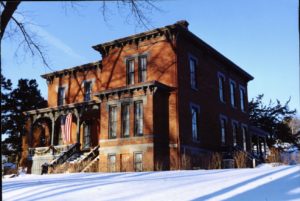On June 27, 1991, Metropolitan Community College (Metro) broke ground on a controversial 199-foot telecommunications tower on the northwest corner of the Fort Omaha campus. The tower’s purpose was to support the distance-learning program so that students could take a class offered on another campus at a closer campus. Two other Metro campuses had distance-learning before it came to the Fort.[i] After battling the Belvedere Point Neighborhood Task Force and others over the tower destroying the historical landscape, the Education Department approved the tower and funding for it.
The State Historical Preservation Office issued a “no-effect” verdict for the proposed tower built on the northwest corner on the Fort Omaha Campus. They applied the criteria outlined in 36 CFR part 800.9 (a) and (b). Preservation Architect Michael Ridone argued that television towers were temporary; therefore, they do not cause permanent damage to the site. “The Fort,” he said, “has been compromised so much, it doesn’t matter what you do to it.” Using the example of Jobber’s Canyon destruction, he continued that, “Omahans don’t care about their history anyway.”[ii]
The Planning Board approved the tower in an, “undeveloped,” corner of the Fort as the “greatest good for the greatest number.” The college performed a 5 years study and consulted 50 experts looking for alternative technologies and locations to put the tower.[iii] Metro argued that the site was the cheapest, and they could not afford to put it anywhere else or use any other method.[iv] The college maintained that the tower presented the, “least possible impact for the fewest number of people at a price that the taxpayer can afford.”[v]
The Belvedere neighborhood group, a neighborhood located northwest of the Fort, tried to stop the tower. The neighborhood taskforce included Warren Flearl, Al Allen, Tom Zimmer, Jeanne Jones, Craig and Kathryn Reisser. A member told the press that, “We’re not just a bunch of weirdo radicals. Maybe because we live in the neighborhood we know a little bit more or care a little bit more about what goes on down there.”[vi] They utilized section 106 of the National Historical Preservation Act of 1966 (NHPA) that ensures federal agencies consider preservation values on historical properties.[vii] They argued that the tower would destroy a historical landmark, a religious landmark, and other viable options existed.[viii]
Fort Omaha’s historical district sits on 80 acres with several historical buildings constructed between 1870 through 1920. In the early 1900s, it housed the Signal Corps and the Balloon School during World War I. The Fort eventually went to the Navy. In 1974, the federal government bestowed national landmark status on the area. The federal government turned the buildings over to Metropolitan Community College in 1975. The location for the tower was right next to the historic Crook House, one of the most famous buildings at Fort Omaha.[ix]
The location was also on the spot where Standing Bear went to pray and gave his farewell speech. To Native Americans, the area was sacred and considered, “Holy Ground.”[x] Standing Bear was a prisoner and could only go where he pleased on the Fort. Ponca tradition requires that Native Americans seek out the highest place to pray. The highest place on the Fort was the hill where the college wanted to build the tower. In historical documents refer to this spot as the, “little hill.” Putting a tower in this location would alter permanently a sacred Native American site. [xi]
They argued that Metro could put the tower on the south end of campus and use Benson High’s or KMTV’s tower as a relay. A tower built on the south end at 270 ft. would provide the same coverage as the proposed northwest corner. Landscaping and painting the base green would not mitigate the adverse effects of the tower. Metro argued that the cost of lights would make the tower cost prohibitive.[xii]
In 1991, Metro got their telecommunication tower. The Belvedere neighborhood association effectively got their point across. They did not stop the tower, but they made it known that Fort Omaha was first the people’s fort, representing an important part of Omaha history. The fight for protecting historical landmarks from progress is a battle fought every day in the United States.
[i] Keith Faur, “Metro Breaks Ground for Tower” (27 June 1991), Omaha World-Herald, pg. 15.
[ii] Nes Latenser, “Letter to Mr. Jerry L. Rogers, Associate Director, Cultural Resources,” 16 November 1990.
[iii] Katheryn Reisser, “Letter to James A. Hanson, Director of Nebraska State Historical Society,” 6 February 1990.
[iv] Ibid.
[v] Rick Ruggles, “Neighborhood Group, Metro Tech at Odds Plans for Ft. Omaha Tower Still Under Siege” (8 January 1990), Omaha World-Herald, pg. 9.
[vi] Ibid.
[vii] Cassie Keener, “The Basics of Section 106 Review” (1 July 2014), National Trust for Historic Preservation, https://savingplaces.org/stories/preservation-tips-tools-basics-section-106-review, accessed 13 February 2020.
[viii] Rick Ruggles, “Neighborhood Group, Metro Tech at Odds Plans for Ft. Omaha Tower Still Under Siege.”
[ix] Ibid.
[x] Katheryn Reisser, “Letter to Manuel Lujan, Secretary to the Department of the Interior,” August 25, 1990.
[xi] Rick Ruggles, “Neighborhood Group, Metro Tech at Odds Plans for Ft. Omaha Tower Still Under Siege.”
[xii] Ibid.
